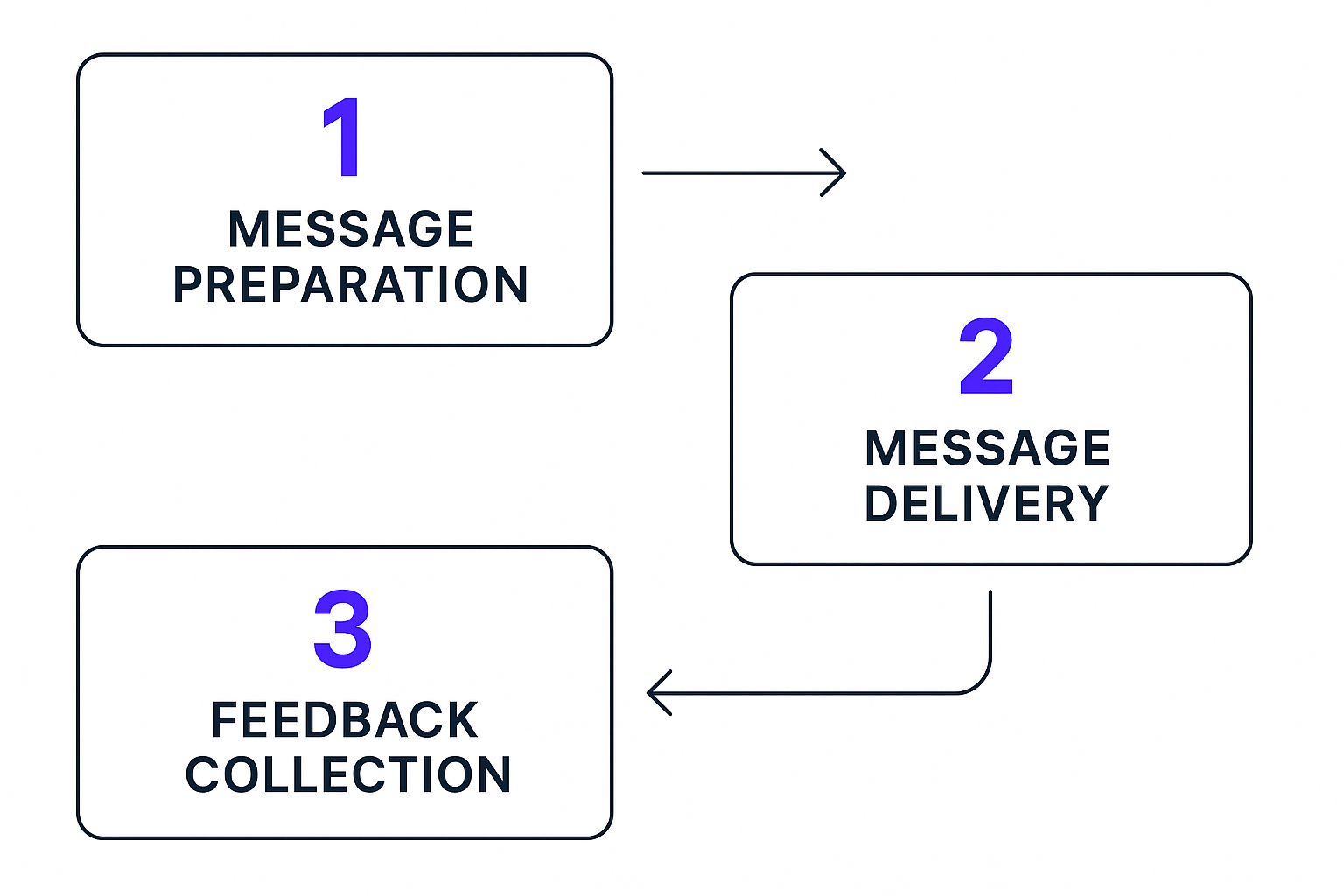Let's be honest: great manager communication isn't just a "soft skill." It's a hard-hitting business function that directly affects your bottom line. Investing in communication skills training for managers is one of the smartest moves you can make to boost productivity, keep your best people, and see real financial returns.
Why Great Manager Communication Is a Business Imperative

It's time to reframe the conversation. For years, communication was treated as a nice-to-have leadership trait. Not anymore. Today, it’s a non-negotiable skill that separates thriving teams from struggling ones, especially in remote and hybrid environments where clarity is everything.
Poor communication isn't just frustrating—it's incredibly expensive.
When managers can't connect effectively, the consequences ripple out. Projects go off the rails because of murky expectations. Talented people walk away because they feel unappreciated. Innovation dies because no one feels safe enough to speak up. This isn't just theory; the costs are tangible and they add up quickly.
The Real Cost of Poor Communication
Think about the direct impact miscommunication has on your business. How many hours has your team wasted redoing work because a manager gave vague instructions? What’s the price tag on replacing a star employee who left because they never got meaningful feedback?
These small fractures compound over time, creating a culture of disengagement and inefficiency. A manager's ability to communicate well is the bedrock needed to build a strong team culture where people feel valued and driven to perform.
The numbers don't lie. A staggering 86% of employees and executives blame most workplace failures on poor communication and collaboration. On the flip side, companies with highly effective communicators enjoy up to a 25% higher employee productivity. The ROI is clear as day.
Bridging the Communication Gap
So often, the company’s big-picture vision gets lost in translation on its way to the team’s daily to-do list. Your managers are that critical link. They're the ones tasked with turning high-level goals into actionable steps and relaying crucial feedback from the front lines back up the chain.
If that link is weak, the whole structure suffers. This is precisely why targeted training is so vital. It gives managers the practical tools they need to:
- Give clear, constructive feedback instead of vague criticism.
- Listen with empathy to understand the root of a problem, not just the symptom.
- Navigate tough conversations with confidence, whether it's about performance or team conflict.
- Inspire and motivate by connecting daily tasks to the bigger "why."
Investing in your managers' ability to communicate is a direct investment in your company's health, productivity, and future growth. It moves communication from an assumed skill to a developed, strategic asset.
Ultimately, these aren't just interpersonal skills; they're operational necessities. When managers communicate clearly, they cut through ambiguity, reduce friction, and build psychological safety. This creates an environment where people can finally do their best work. If your teams are tangled in misunderstandings, learning how to overcome communication barriers is a crucial starting point: https://www.remotesparks.com/how-to-overcome-communication-barriers/
The table below breaks down the tangible business impact of getting this right.
The Business Impact of Manager Communication Skills
The difference between poor and effective communication shows up in every key business metric. It's the gap between a team that's just surviving and one that's truly thriving.
| Area of Impact | Consequences of Poor Communication | Benefits of Effective Communication |
|---|---|---|
| Employee Engagement | High absenteeism, low morale, and lack of initiative. | Increased motivation, higher job satisfaction, and proactive problem-solving. |
| Productivity | Missed deadlines, wasted resources, and frequent rework. | Efficient workflows, higher quality output, and improved project success rates. |
| Talent Retention | High employee turnover and increased recruitment costs. | Greater employee loyalty, reduced turnover, and a stronger employer brand. |
| Innovation | Fear of sharing new ideas, resistance to change, and stagnation. | A culture of psychological safety that encourages creativity and continuous improvement. |
As you can see, strengthening these abilities isn't just about making the workplace more pleasant—it's a core strategy for building a more resilient, innovative, and profitable business.
The Four Pillars of Effective Manager Communication

Great communication isn't some abstract corporate theory. It’s a practical skill built on four core abilities. I like to think of them as the legs on a table—if one is wobbly, the whole thing is unstable. Getting these right is the whole point of any solid communication skills training for managers.
Each of these pillars helps you solve a real challenge you face every single day, whether it's figuring out what your team really needs or guiding them through a tough transition. Let’s dig into what they are and how you can start using them right away.
Pillar One: Active Listening
This is so much more than just waiting for your turn to talk. It's about hearing the subtext—the things that aren't being said. The difference between active listening and just hearing is like the difference between treating a symptom and actually diagnosing the root cause.
So many managers I've worked with jump straight into "solution mode." Someone on their team mentions a problem, and they immediately offer a fix. It comes from a good place, but it often misses the real issue. Maybe that "roadblock" isn't a technical snag but a symptom of burnout or friction between teammates.
Active listening is about absorbing, understanding, and truly retaining what someone tells you. It is the fastest way to build trust and psychological safety on your team.
Here's how to get better at it:
- Paraphrase and clarify. Don't just assume you got it. Repeat back what you heard in your own words. Something as simple as, "Okay, so if I'm understanding you correctly, the biggest hurdle here is…" can work wonders. It shows you're engaged and helps you catch any misinterpretations on the spot.
- Ask open-ended questions. Move beyond questions that get a simple "yes" or "no." Try prompts like, "Can you walk me through how you got to that point?" or "What would a perfect outcome look like for you?" These questions invite a real conversation.
Pillar Two: Clear and Constructive Feedback
Feedback is a gift, but only when it's wrapped properly. Vague, poorly timed, or overly critical feedback will crush morale faster than anything else. Your goal should always be to build people up, focusing on specific actions and their impact, not on personality traits.
Think about this classic bad example: a manager tells someone, "Your presentation just wasn't very engaging." That's completely useless. It's vague, subjective, and leaves the person feeling crummy with no idea how to improve.
A much better approach zeroes in on observable behaviors and opens the door for collaboration.
A Quick "Try This, Not That" Guide
| Instead Of This (Vague and Critical) | Try This (Specific and Constructive) |
|---|---|
| "You need to be more proactive in meetings." | "I noticed you didn't get a chance to share your ideas in today's sync. In our next meeting, I'd like to carve out some time for you to present your findings on the Q3 data." |
| "Your report was confusing." | "The data in this report is fantastic. To make sure the execs grasp the key takeaways, let's add a summary slide at the beginning that calls out the top three findings." |
See the difference? You've just turned a critique into a coaching moment, which is the secret to building high-performance teams that are hungry for growth.
Pillar Three: Navigating Difficult Conversations
Let's be honest, nobody enjoys having tough conversations. Whether it’s addressing poor performance, mediating a conflict, or delivering bad news, it's uncomfortable. But avoiding these conversations just lets the problem fester and grow. The trick is to walk in with a plan, a dose of empathy, and a clear focus on finding a solution.
When we're faced with conflict, our brains tend to go into fight-or-flight mode. At work, that can look like getting defensive or just ignoring the issue entirely. A trained manager knows there's a third option: facilitate.
Imagine two of your direct reports are at odds over project responsibilities. An untrained manager might tell them to "work it out" or just ignore it. A skilled manager, on the other hand, would:
- Meet with each person one-on-one to hear their side of the story without judgment.
- Bring them together for a facilitated discussion that centers on shared goals, not personal attacks.
- Help them clarify their roles and agree on a communication plan to keep things from boiling over again.
This structured approach takes the emotion out of the conflict and turns it into an opportunity to make the team's processes even stronger.
Pillar Four: Mastering Digital Cues
With so many of us working in remote or hybrid teams, how you come across on Slack, email, and video calls is incredibly important. Without body language and tone of voice, your messages can easily be misinterpreted.
Being a good digital communicator means being intentional. For example, a blunt Slack message like "We need to talk about your report" is guaranteed to cause anxiety. But a little context and a positive spin change everything: "Hey, I was looking over your report and have a few ideas that I think could make it even more powerful. Got 15 minutes to connect this afternoon?"
This final pillar is all about applying timeless communication principles to the tools we rely on every day. It’s what ensures your leadership comes through as clear, supportive, and effective, no matter where your team members are logging in from.
Choosing the Right Communication Training Format

Alright, so you're committed to sharpening your team's communication skills. That's a huge first step. Now for the tricky part: how do you actually deliver the training? The format you pick is more important than you might think—it can be the difference between a game-changing program and a total flop.
There’s no magic bullet here. The best approach depends entirely on your team's day-to-day realities, your company culture, and what you’re trying to achieve. Think of it like a personal fitness plan. Some people love the energy of a group class, while others need the flexibility of a solo workout. Let's break down the most common options to find the right fit for your managers.
Instructor-Led Training In Person and Virtual
This is the classic classroom setup, whether you’re gathered in a conference room or logged into a video call. The biggest win with Instructor-Led Training (ILT) is the real-time, human connection. Your managers can ask questions on the spot, bounce ideas off each other, and get immediate feedback from an expert facilitator.
This format truly shines when you're tackling complex skills, like navigating tough conversations. Nothing beats live role-playing with a coach who can offer pointers in the moment. The obvious downside? Logistics. Getting every busy manager in the same place at the same time can feel like herding cats.
My take: The shared experience is what makes ILT so powerful. When managers learn together, they start using the same language and frameworks, which builds much-needed consistency across the company.
Self-Paced eLearning Modules
For managers with calendars that look like a game of Tetris, eLearning is a lifesaver. These online courses let them learn whenever and wherever it works for them—on a flight, between meetings, or late at night. They can move at their own pace and rewind a lesson if a concept doesn't click right away.
And don't picture boring, click-through slideshows. Modern eLearning is packed with interactive quizzes, video scenarios, and helpful templates. But the trade-off is the lack of live interaction. It can feel a bit isolating, and without a facilitator to keep the energy up, it's easier for people to tune out.
High-Impact Simulations and Role-Playing
This is where the rubber really meets the road. Simulations aren't so much a standalone format as they are a crucial ingredient you can add to any training. By throwing managers into realistic scenarios—like delivering negative feedback or mediating a conflict—they build real muscle memory.
It's one thing to read about a communication technique, but it’s another thing entirely to try it under pressure. These exercises create a safe space to practice, make mistakes, and get better without any real-world consequences. This is how knowledge becomes a durable, go-to skill.
The Blended Learning Approach
So, which one is best? Often, the answer is "all of the above." A blended approach cherry-picks the best elements from each format to create a much more effective and lasting learning experience.
Here’s a common way to structure a blended program:
- Lay the Groundwork: Managers start with self-paced eLearning modules to get familiar with the core ideas and frameworks on their own time.
- Practice Together: Next, they come together for a live workshop (virtual or in-person) to practice what they've learned through role-playing and group problem-solving.
- Keep it Going: The learning doesn't stop there. You can provide ongoing support through peer coaching groups or by sending out quick, bite-sized refreshers via email or Slack.
This model respects everyone's time while still delivering the hands-on practice needed to make these skills stick. For managers looking to elevate their entire team's performance, these skills can be further developed through comprehensive business team coaching, which builds on this individual foundation. By mixing and matching, you appeal to different learning styles and ensure your investment in training actually pays off.
A Practical Framework for Building Your Skills
Knowing the right things to say is one thing. Actually saying them effectively when you're under pressure is another beast entirely. Building great communication habits isn't something you can cram for like a test; it's much more like training for a marathon. It takes a structured approach and consistent practice.
This framework is designed to give you a clear path for turning theory into a real-world skill set. Think of it as a continuous cycle: you assess where you are, focus your effort, practice deliberately, and then refine your approach. By breaking it down, you can make steady, real progress without getting overwhelmed.
This is a great visual of the key stages involved, from getting ready to getting feedback.

As you can see, solid communication is a complete loop. It's never just a one-way street.
First, A Reality Check: The Self-Assessment
You can’t figure out how to get somewhere until you know where you’re starting from. The first move is always an honest self-assessment to pinpoint your personal communication gaps. It's easy to think we're clear communicators, but often our impact doesn't quite match our intent.
Take a few minutes to think about your recent interactions at work. When did you feel most in control? And where did things get a little tense, confusing, or just plain awkward?
- Tough Conversations: Do you find yourself putting off performance discussions or stepping around team conflicts?
- Giving Feedback: Is your feedback specific and helpful, or does it sometimes land as vague or a bit too critical?
- Running Meetings: Do your meetings wrap up with everyone knowing exactly what to do next, or do they tend to drift?
- Just Listening: In your one-on-ones, are you really dialed in to understand, or are you just waiting for your turn to talk?
You have to be brutally honest here. This isn't about beating yourself up; it's about getting the data you need to focus your energy where it'll make the biggest difference.
Set Small, Winnable Goals
Once you have a clearer picture of what to work on, resist the temptation to fix everything at once. Trying to master all four pillars of communication overnight is a fast track to burnout. Instead, just pick one or two specific things to tackle over the next month.
Good goals turn a vague wish like "I want to communicate better" into an actual plan.
My Pro-Tip: Your goal should be small enough to practice daily or weekly. For instance, instead of "run better meetings," try this: "For every meeting I lead this week, I will end with a 3-minute recap of decisions and action items."
This tight focus allows you to practice deeply and build real momentum. Once you feel solid in that one area, you can layer on the next skill. For managers looking to scale this, learning how to create interactive videos for corporate training is a fantastic way to practice and share these techniques with your whole team.
Get Your Reps In With Deliberate Practice
This is where the magic happens—where knowledge starts to feel like a natural skill. Deliberate practice isn't just going through the motions of your job. It means you’re intentionally working on your chosen skill with the specific goal of getting better.
Here are a few simple exercises you can try, tied to the four pillars:
- For Active Listening: In your next three one-on-ones, make it your only goal to ask open-ended, clarifying questions. Before you jump in with a solution, say something like, "Help me understand a bit more about…" Then, repeat back what you heard to make sure you got it right.
- For Constructive Feedback: Try the Situation-Behavior-Impact (SBI) model for your next feedback chat. Actually write it out beforehand: describe the specific situation, the observable behavior, and the tangible impact it had.
- For Difficult Conversations: Before a really tough conversation, just script out your opening sentence. Seriously. Having a calm, neutral opener locked and loaded can keep you from kicking things off on an emotional or accusatory note.
- For Meeting Effectiveness: If you want to tighten up your meetings, a simple checklist can work wonders. Our guide on https://www.remotesparks.com/how-to-run-effective-meetings/ has some practical templates and tips you can put to use right away.
This short, focused practice is how you build muscle memory. Here’s a sample schedule to show you how easy it is to fit into a busy week.
Manager's Weekly Communication Practice Plan
| Day of the Week | Focus Skill | 15-Minute Practice Exercise |
|---|---|---|
| Monday | Meeting Effectiveness | Review the agenda for your most important meeting this week. Write down one question to ask that will spark discussion and engagement. |
| Tuesday | Active Listening | During a team check-in, pick one person and focus solely on listening to their update without interrupting. Paraphrase their key point back. |
| Wednesday | Constructive Feedback | Draft one piece of positive feedback using the SBI model (Situation-Behavior-Impact) to share with a team member. |
| Thursday | Difficult Emotions | Think of a recent frustrating interaction. Spend 10 minutes journaling about your emotional response and what triggered it. |
| Friday | Seeking Feedback | Send a quick message to a trusted colleague: "Hey, I'm working on my clarity. Was my email about Project X easy to understand?" |
A simple plan like this makes consistent improvement feel manageable, not monumental.
Finally, Ask How You're Doing
You need a way to know if any of this is actually working. The best way to find out if your communication is hitting the mark is to ask the people on the other end. I know, it can feel a little intimidating, but it's the only way to close the loop.
Don't just ask, "How am I doing?" That's way too broad and puts people on the spot.
Get specific. You could pull a trusted team member aside and say, "In our last project meeting, I really tried to make sure everyone had a chance to speak. How did that feel from your side of the table?" Or, after giving feedback, you could follow up with, "Was that helpful and clear for you?"
Asking for feedback this way gives you insights you can actually use, and it goes a long way toward building a culture where feedback is just a normal, healthy part of how you work together. This cycle—Assess, Goal-Set, Practice, and Seek Feedback—is your engine for getting better and better over time.
Your Personal Communication Action Plan
Knowing what to do is one thing. Actually doing it consistently is where the real magic happens. This is the part where we move from theory to practice. An action plan isn't some grand, intimidating document; it's simply a commitment to making small, manageable changes that will create a positive ripple effect across your team.
Lasting improvement in communication isn’t a one-and-done deal. It's a continuous cycle of practice, reflection, and small course corrections along the way. Your goal is to build momentum, one conversation at a time.
Commit to One Small Change This Week
The fastest way to get started is to focus on a single, high-impact behavior. If you try to become a master of active listening, constructive feedback, and conflict resolution all at once, you're just setting yourself up for failure. Pick one specific thing you can do right away.
This "micro-commitment" makes progress feel real and builds your confidence.
Here are a few ideas to get you started:
- For Active Listening: "In my next one-on-one, I won't offer a single solution until I've asked at least two clarifying questions, like 'Can you tell me more about that?'"
- For Clearer Feedback: "I will use the Situation-Behavior-Impact model to give one piece of positive feedback to someone on my team this week."
- For Meeting Management: "Before my next team meeting wraps up, I'll spend the last three minutes summarizing decisions and assigning a clear owner to each action item."
Pick one that feels right based on your self-assessment and literally write it down. Just the act of putting it on paper makes you far more likely to follow through.
An action plan turns a vague goal into a concrete roadmap. Committing to a single, specific change is the most powerful first step you can take toward becoming a more effective communicator.
This isn't just an internal priority; it's a major economic trend. The market for soft skills development, including communication skills training for managers, hit USD 33.4 billion in 2024. It’s projected to climb to an astonishing USD 92.6 billion by 2033. That number shows just how much organizations are realizing these skills are critical business assets.
The Ripple Effect of Tiny Adjustments
It’s easy to downplay the impact of a small shift in how you communicate. But think about it: one piece of well-delivered feedback can re-engage an employee who was starting to check out. One well-run meeting can save your team hours of confusion and rework.
These small adjustments send a huge signal to your team—that you're invested in their success, their clarity, and their growth. This fosters psychological safety, which in turn encourages people to speak up. When your team feels genuinely heard, they bring better ideas to the table, which is a game-changer for improving virtual team engagement.
Your Ongoing Journey to Great Communication
Becoming a great communicator is a process, not a destination. Some weeks, you’ll feel like you’re making incredible progress. Other times, you might slip back into old habits, especially when you're under pressure. That’s completely normal. The key is to treat every interaction as a fresh opportunity to practice.
Stay curious about your own patterns. Check in with yourself and your team regularly. A simple question like, "Was my feedback on that last project helpful for you?" can give you incredibly valuable insight for your next conversation.
Ultimately, your commitment to better communication is one of the best investments you can make—in your team, in your projects, and in your own career. It's the one skill that unlocks potential, builds trust, and drives performance more than anything else. Your journey starts now, with that one small change.
Got Questions About Manager Communication Training?
Even when you know how crucial it is, starting communication skills training for managers can feel a bit overwhelming. Let's walk through some of the questions I hear most often from leaders just like you.
How Can I Actually Measure the ROI of This Training?
This is a big one. It's tempting to look for a single, simple number, but the real return on investment shows up in two places: the hard data and the day-to-day team atmosphere. You need to track both.
For the quantitative side, you’ll want to get a baseline of these metrics before you start any training:
- Employee Turnover Rates: A noticeable drop in people leaving voluntarily is a huge win. It often means managers are building a place where people want to stay.
- Team Productivity: Are projects getting done faster? Is there less rework? Clearer communication directly cuts down on wasted time and speeds up workflows.
- Absenteeism: When people are less stressed and more engaged, they tend to take fewer sick days.
On the qualitative side, use tools like pulse surveys or 360-degree feedback. You're looking for an uptick in things like team morale and psychological safety. When you put both the hard numbers and the cultural shifts together, you get a really clear picture of the training's impact.
What's the First Skill a New Manager Absolutely Must Learn?
If you can only pick one, it has to be active listening. Hands down. It’s the bedrock for every other communication skill, from giving good feedback to building real trust.
Most new managers are eager to make an impact. They want to fix things and show they're capable, which often leads them to jump in with solutions before they fully grasp the problem. Active listening forces them to slow down and really hear what their team is saying—and just as importantly, what they aren't saying.
Mastering listening first prevents countless misunderstandings. It makes your people feel heard and respected, and ultimately, it helps you make much smarter decisions. Everything else builds on this foundation.
How Do I Give Tough Feedback Without Crushing Someone's Morale?
This is probably the conversation every manager dreads. The secret is to frame it as a problem-solving session, not a critique of the person. My go-to method for this is the Situation-Behavior-Impact (SBI) model.
It’s a simple but powerful framework:
- Situation: Pinpoint the specific "when and where." For example, "During yesterday's client presentation…"
- Behavior: Describe exactly what you saw or heard, sticking to the facts. "…I noticed you spoke over the client twice while they were asking questions."
- Impact: Explain the result of that behavior. "The impact was that we didn't get to the root of their concern, and I felt the room get a little tense."
This method keeps the focus on a specific action and its outcome, not on someone’s personality. It feels objective and actionable. By framing the whole conversation around growth and showing you believe in their ability to improve, you turn a tough talk into a real coaching moment. Developing this skill is also a huge part of learning how to engage remote employees.
Ready to transform your team's creative potential? Bulby provides a structured, AI-guided platform that turns chaotic brainstorming sessions into focused, productive collaboration. Learn how Bulby can help your remote team generate its next big idea.

